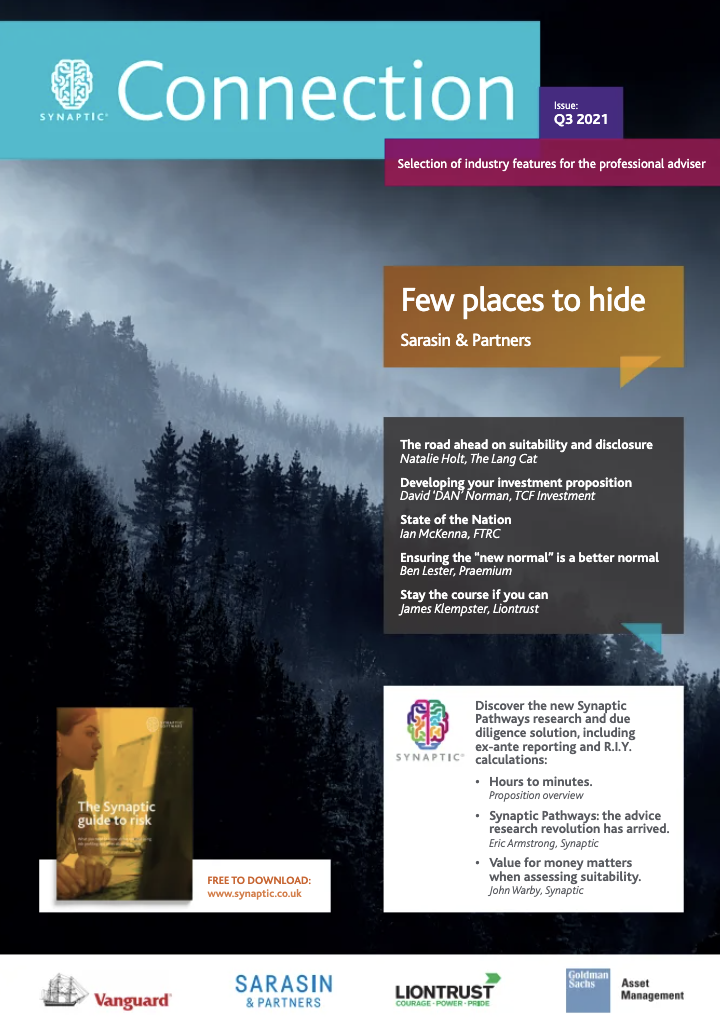In this edition...
- Hours to minutes Editorial team, Synaptic Software Limited
- Synaptic Pathways: the advice research revolution has arrived Eric Armstrong, Client Director, Synaptic Software Limited
- Value for money matters when assessing suitability John Warby, Senior Business Relationship Manager, Synaptic Software Limited
- The road ahead on suitability and disclosure Natalie Holt, Content Editor The Lang Cat
- Developing your investment proposition David A Norman (DAN), CEO TCF Investment
- State of the Nation Ian McKenna, Founder of Financial Technology Research Centre and AdviserSoftware.com FTRC
- Few places to hide Guy Monson, CIO and Senior Partner Sarasin & Partners
- Ensuring the “new normal” is a better normal Ben Lester, Head of Distribution – UK & International Praemium
- Stay the course if you can (but better too early than too late) James Klempster, Deputy Head of the Liontrust Multi-Asset team Liontrust
- Can financial goals be achieved through one fund? Mohneet Dhir, Multi-Asset Product Specialist Vanguard Europe
- Talking Trash: Why it’s not a waste of time Luke Barrs, Head of Fundamental Equity Client Portfolio Management for EMEA & Asia ex-Japan Goldman Sachs Asset Management
- Demand for growth funds rises amid risk-on environment Antony Champion, Head of Intermediaries Brewin Dolphin
- The best of both worlds Ian Jensen-Humphreys, Portfolio Manager Quilter Investors
- Global Sustainable Equity: a renewable, electric and digital future Hamish Chamberlayne, Head of Global Sustainable Equities | Portfolio Manager Janus Henderson
- Four steps to choose an ESG manager Daniel Ryan, Manager Research Analyst Fidelity International
- The path to retirement is changing … are you? Editorial team, Synaptic Software Limited
- Are unregulated investments ever a good idea? Jon Lycett, Business Development Manager RSMR
- Putting the children first Jacqui Gillies, Marketing and Proposition Director Guardian
- Why not Serious Illness Cover? Nick Telfer, Protection Development Manager VitalityLife
The investment industry has done its best to polarise investors between active and passive investment strategies. This is a shame as great things can happen if you combine the two correctly, say the co-managers of the Quilter Investors Cirilium Blend Portfolios.

"Cirilium Blend Portfolios were designed to be a highly cost-effective, long-term growth solution, they're run to a demanding cost ceiling. This means we need to have a clear approach to how we deploy our capital in order to get the most 'bang' for our 'buck'."
The idea of building a range of long-term, multi-asset growth portfolios that combine the most desirable attributes of both active and passively managed funds, has much to commend it.
Fundamentally, we believe that, given time, talented active managers offer the potential for long-term outperformance of market indices (or 'alpha'). Meanwhile, passive funds present the means to track any number of markets or industry sectors for a fraction of the cost of active management.
Recognising the problem
In the Cirilium Portfolio range, we employ passive exposures as a cost-effective way to implement our tactical asset allocation (TAA) decisions. However, in the Cirilium Blend Portfolios we go above and beyond this by trying to combine active and passive approaches to create the greatest amount of worthwhile, active diversification for the lowest total cost.
This means finding active managers who have the freedom to pursue the best opportunities they unearth and to steer their own course through market dislocations (such as lockdown). Consequently, the return profile from such funds – namely the 'investment journey' – they deliver is quite different from that of regional market indices. To do otherwise risks creating a portfolio made up of tracker funds on one side and 'closet trackers' on the other.
Key considerations
Because the Cirilium Blend Portfolios were designed to be a highly cost-effective, long-term growth solution, they're run to a demanding cost ceiling. This means we need to have a clear approach to how we deploy our capital in order to get the most 'bang' for our 'buck'.
As a rule, we're happy to pay for active management where we have confidence that, given time, the manager in question can generate 'alpha' (namely market outperformance) from their approach. In areas where we don't have such confidence that active managers can outperform – often in what are referred to as more 'efficient markets' because there's a high level of market information priced in – we're happy to take the lower costs of passive exposure to capture the 'beta', or market returns, that are on offer.
The 'big' question
Similar considerations attend the age-old 'large cap versus small cap' question. Smaller companies theoretically have greater prospects for high levels of growth given their nimbleness and ability to gain market share from larger incumbents. In theory then, smaller stocks should generate higher returns for investors. This logic has been turned on its head somewhat given the coronavirus outbreak where large cap stocks have benefited from their dominant positions, notably in the online retail space as well as in software.
The strong outperformance of the large cap stocks has pushed valuations higher, while increased regulatory scrutiny and the increasingly fractious nature of international relations are all developments that could potentially upset the apple cart for big international companies.
If this happens, it could well trigger a period of outperformance for more agile, smaller companies that tend to be more domestically focused. In this sort of scenario, conventional index-tracking funds are likely to suffer most of the pain, but little of the gain.
Similarly, passive funds will struggle if 'value' strategies start to outperform. Today, most market indices (with the notable exception of the UK) are dominated by 'growth' stocks which means the funds that track them are, likewise, skewed towards 'growth'.
Balancing act
All this means that any 'hybrid' portfolio will need to balance the risks of passive investment with exposure to the best active managers in their respective sectors.
Finding the right balance of active and passive approaches requires global fund research and investment analysis. It also requires a significant degree of investment scale; this is what grants access to such a broad swathe of different asset classes, geographies and investment strategies at competitive cost levels.
Scale is also important when it comes to seeding new active strategies that complement the needs of a hybrid portfolio. For example, finding active managers with a 'value' bias that balances the natural 'growth' bias of passive funds or smaller companies strategies that balance out the dominance of larger companies in passive funds.
In technical terms, passive funds provide us with 'beta' (i.e. market returns) while our active managers provide the potential for 'alpha', namely market outperformance.
Even so, because we're always asking ourselves what could go wrong with the investment positions we take, it also helps to have dedicated derivative trading capabilities to hedge any unwanted risks that might arise along the way.
Fortunately, the Cirilium Blend Portfolios have all of these capabilities, which explains why they include so many highly active funds from managers with the freedom to pursue their best investment ideas.
For more information on the Cirilium Blend portfolios visit quilterinvestors.com/solutions/cirilium-blend-range
Important information
Investment involves risk. The value of investments and the income from them may go down as well as up and investors may not get back the amount originally invested. Because of this, an investor is not certain to make a profit on an investment and may lose money. Exchange rate changes may cause the value of overseas investments to rise or fall.
This communication is issued by Quilter Investors Limited (“Quilter Investors”), Senator House, 85 Queen Victoria Street, London, England, EC4V 4AB. Quilter Investors is registered in England and Wales (number: 04227837) and is authorised and regulated by the Financial Conduct Authority (FRN: 208543).
Quilter Investors Cirilium Adventurous Blend Portfolio, Quilter Investors Cirilium Balanced Blend Portfolio, Quilter Investors Cirilium Conservative Blend Portfolio, Quilter Investors Cirilium Dynamic Blend Portfolio, and Quilter Investors Cirilium Moderate Blend Portfolio (“the funds”), are sub-funds of Quilter Investors Cirilium OEIC, an investment company with variable capital incorporated in England and Wales.
Quilter Investors Cirilium OEIC is authorised by the Financial Conduct Authority as a non-UCITS retail scheme and can be distributed to the public in the United Kingdom.
Quilter Investors uses all reasonable skill and care in compiling the information in this communication which is accurate only on the date of this communication. You should not rely upon the information in this communication in making investment decisions. Nothing in this communication constitutes advice or personal recommendation. An investor should read the Key Investor Information Document(s) (“KIID”) before investing in any sub-fund of Quilter Investors Cirilium OEIC. The KIID and the prospectus can be obtained from www.quilterinvestors.com/cirilium in English.
The funds invest principally in other collective investment schemes. Your attention is drawn to the stated investment policy which is set out in the prospectus.
Sign up for updates
Keep up to speed with everything you need to know each quarter, by email or post.


